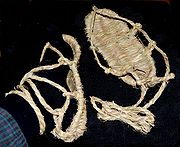
Waraji
Encyclopedia

Sandal (footwear)
Sandals are an open type of outdoor footwear, consisting of a sole held to the wearer's foot by straps passing over the instep and, sometimes, around the ankle...
made from straw
Straw
Straw is an agricultural by-product, the dry stalks of cereal plants, after the grain and chaff have been removed. Straw makes up about half of the yield of cereal crops such as barley, oats, rice, rye and wheat. It has many uses, including fuel, livestock bedding and fodder, thatching and...
rope
Rope
A rope is a length of fibres, twisted or braided together to improve strength for pulling and connecting. It has tensile strength but is too flexible to provide compressive strength...
that in the past were the standard footwear of the common people in Japan
Japan
Japan is an island nation in East Asia. Located in the Pacific Ocean, it lies to the east of the Sea of Japan, China, North Korea, South Korea and Russia, stretching from the Sea of Okhotsk in the north to the East China Sea and Taiwan in the south...
. Waraji were also worn by the samurai
Samurai
is the term for the military nobility of pre-industrial Japan. According to translator William Scott Wilson: "In Chinese, the character 侍 was originally a verb meaning to wait upon or accompany a person in the upper ranks of society, and this is also true of the original term in Japanese, saburau...
class and foot soldiers (ashigaru
Ashigaru
The Japanese ashigaru were foot-soldiers of medieval Japan. The first known reference to ashigaru was in the 1300s, but it was during the Ashikaga Shogunate-Muromachi period that the use of ashigaru became prevalent by various warring factions.-Origins:Attempts were made in Japan by the Emperor...
) during the feudal era of Japan.
Description
Traditionally the rope material was made of rice straw, however waraji can be made out of various other materials such as hemp, stalks of myōgaMyoga
Myōga or myoga ginger is an herbaceous, deciduous, perennial native to Japan and southern part of Korea that is grown for its edible flower buds and flavorful shoots. Flower buds are finely shredded and used in Japanese cuisine as a garnish for miso soup, sunomono and dishes such as roasted...
, palm fibers, and cotton thread. Now they are mostly worn by traditional Buddhist monks.
Traditionally, the Japanese wear the waraji with their toes protruding slightly over the front edge. However, there are no set rules or guidelines on wearing waraji.
Remnants of Baekjae-era straw footwear that is similar to the Japanese waraji had been found in Gungnamji (궁남지) Buyeo County
Buyeo County
Buyeo County is a county in South Chungcheong Province, South Korea. Buyeo-eup, the county's capital, was the site of the capital of the Baekje kingdom from AD 538 to 660, when it was called Sabi....
, South Korea
South Korea
The Republic of Korea , , is a sovereign state in East Asia, located on the southern portion of the Korean Peninsula. It is neighbored by the People's Republic of China to the west, Japan to the east, North Korea to the north, and the East China Sea and Republic of China to the south...
.

